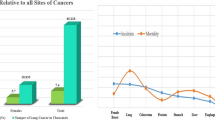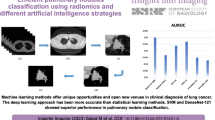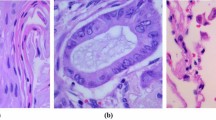Abstract
Lung cancer is the primary cause of mortality globally in both males and females, underscoring the urgent requirement for rapid and accurate methods of early detection for this condition. Computer-aided diagnosis systems have demonstrated their effectiveness and efficiency in the medical industry for the past twenty years. However, when working with large datasets, difficulties emerge, particularly with efficiency, especially when employing time-consuming deep learning models. This study aims to introduce a novel hybrid model that utilizes the advantages of effective deep learning models, specifically the Convolutional Neural Network, to extract a significant number of features. Subsequently, the model selects the most pertinent characteristics, reducing intricacy and enhancing effi- cacy within a shorter timeframe. This methodology utilizes the Densenet201 model to extract features and subsequently applies Principal Component Analysis (PCA) to decrease dimensionality and conduct feature selection. Afterward, a multilayer perceptron is used for categorization. Furthermore, to address the model’s explainability, Local Interpretable Model-Agnostic explanations (LIME) are used to explain the model’s individual prediction. The performance of the LIDC-IDRI dataset was exceptional during both the training and validation phases of evaluation. The accuracy rate reached 99.22%, while the validation accuracy rate was 99.41%, with a precision of 99.97%, a sensitivity of 100%, an area under the curve of 99.99%, and a specificity of 99.81% and an F1-score of 99.83%. External validation was also used to evaluate the approach’s generaliz- ability, the model achieved an accuracy of 98.88%, an area under the curve of 99.97%, a specificity of 97.76%, and an F1-score of 98.86%. The execution dura- tion was 186 s for training and 30 s for validation. Future efforts will prioritize the efficiency of the technique while yet keeping it simple.













Similar content being viewed by others

References
Ali MU, Miller J, Peirson L, Fitzpatrick-Lewis D, Kenny M, Sherifali D, Raina P. Screening for lung cancer: a systematic review and meta-analysis. Prev Med. 2016;89:301–14. https://doi.org/10.1259/bjr.20160406.
Armato SG, McLennan IIIG, Bidaut L, McNitt-Gray MF, Meyer CR, Reeves AP, Zhao B, Aberle DR, Henschke CI, Hoffman EA, et al. The lung image database consortium (lidc) and image database resource initiative (idri): a completed reference database of lung nodules on ct scans. Med Phys. 2011;38(2):915–31. https://doi.org/10.1118/1.3528204.
Asuntha, Srinivasan A. Deep learning for lung cancer detection and classification. Multimedia Tools Appl. 2020;79(11):7731–62. https://doi.org/10.1007/s11042-019-08394-3.
Bayanati H, Thornhill RE, Souza CA, Sethi-Virmani V, Gupta A, Maziak D, Amjadi K, Dennie C. Quantitative ct texture and shape analysis: can it differentiate benign and malignant mediastinal lymph nodes in patients with primary lung cancer? Eur Radiol. 2015;25:480–7. https://doi.org/10.1007/s00330-014-3420-6.
Bhandary GA, Prabhu V, Rajinikanth KP, Thanaraj SC, Satapa- thy DE, Robbins C, Shasky Y-D, Zhang JMR, Tavares. Raja. Deep-learning framework to detect lung abnormality–a study with chest x-ray and lung ct scan images. Pattern Recognit Lett. 2020;129:271–8. https://doi.org/10.1007/s11042-019-08394-3.
Bilal M, Shafiq F, Fang M, Waqar I, Ullah YY, Ghadi H, Long, Zeng R. Igwo-ivnet3: Dl-based automatic diagnosis of lung nodules using an improved gray wolf optimization and inceptionnet-v3. Sensors. 2022;22(24):9603. https://doi.org/10.3322/caac.21820.
Boita J, van Engen RE, Mackenzie A, Tingberg A, Bosmans H, Bolejko A, Zackrisson S, Wallis MG, Ikeda DM, Van Ongeval C, et al. How does image quality affect radiologists’ perceived ability for image interpretation and lesion detection in digital mammography? Eur Radiol. 2021;31:5335–43. https://doi.org/10.1007/s00330-020-07679-8.
Bose ˚AM, Khan Bukholm IR, Bukholm G, Geitung JT. A national study of the causes, consequences and amelioration of adverse events in the use of mri, ct, and conventional radiography in Norway. Acta Radiol. 2020;61(6):830–8. https://doi.org/10.1177/02.84185119881734.
Bouamrane, Derdour M. 2023 International Conference on Networking and Advanced Systems (ICNAS), pages 1–6. IEEE, 2023. https://doi.org/10.1109/ICNAS59892.2023.10330504
Brea TP, Ravin˜a AR, G´omez AG, de Alegr´ıa AM, Vald`ec L, et al. Use of magnetic resonance imaging for n-staging in patients with non-small cell lung cancer. A systematic review. Arch De Bronconeumolog´ıa (English Edition). 2019;55(1):9–16.
Cassim S, Chepulis L, Keenan R, Kidd J, Firth M. Lawren- son. Patient and carer perceived barriers to early presentation and diag- nosis of lung cancer: a systematic review. BMC Cancer. 2019;19:1–14. https://doi.org/10.1186/s12885-018-5169-9.
Clark K, Vendt B, Smith K, Freymann J, Kirby J, Koppel P, Moore S, Phillips S, Maffitt D, Pringle M, et al. The cancer imaging archive (tcia): main- taining and operating a public information repository. J Digit Imaging. 2013;26:1045–57. https://doi.org/10.1007/s10278-013-9622-7.
Davis T, Palmer AL, Nisbet A. Can ct scan protocols used for radio- therapy treatment planning be adjusted to optimize image quality and patient dose? A systematic review. Br J Radiol. 2017;90(1076):20160406. https://doi.org/10.1259/bjr.20160406.
Decazes P, Hinault P, Veresezan O, Thureau S, Gouel P, Vera P. Tri- modality pet/ct/mri and radiotherapy: a mini-review. Front Oncol. 2021;10:614008. https://doi.org/10.3389/fonc.2020.614008.
Elicker M, Kallianos KG, Henry TS. The role of high-resolution com- puted tomography in the follow-up of diffuse lung disease: number 2 in the series radiology edited by Nicola Sverzellati and sujal desai. Eur Respiratory Rev. 2017;26(144). https://doi.org/10.1183/16000617.0008-2017.
Gong J, Liu J, Hao W, Nie S, Wang S, Peng W. Computer- aided diagnosis of ground-glass opacity pulmonary nodules using radiomic features analysis. Phys Med Biol. 2019;64(13):135015. https://doi.org/10.1088/1361-6560/ab2757.
Guo Y, Lin Q, Wang Y, Cao X, Cao Y, Man Z, Zeng X, Huang X. Inte- grating transfer learning and feature aggregation into self-defined convolutional neural network for automated detection of lung cancer bone metastasis. J Med Biol Eng. 2023;43(1):53–62.
Hu X, Chu L, Pei J, Liu W, Bian J. Model complexity of deep learning: a survey. Knowl Inf Syst. 2021;63:2585–619. https://doi.org/10.1007/s10115-021-01605-0.
Huang G, Liu Z, Van Der Maaten L. and K. Q. Weinberger. Densely connected convolutional networks. In Proceedings of the IEEE conference on computer vision and pattern recognition, pages 4700–4708, 2017.
Hussain Ali Y, Sabu Chooralil V, Balasubramanian K, Manyam RR, Raju K, Sadiq AT. Farhan. Optimization sys- tem based on convolutional neural network and internet of medical things for early diagnosis of lung cancer. Bioengineering. 2023;10(3):320. https://doi.org/10.3390/bioengineering10030320.
Khalid S, Khalil T, Nasreen S. A survey of feature selection and fea- ture extraction techniques in machine learning. In 2014 science and information conference, pages 372–378. IEEE, 2014.
L´opez-L´azaro M. The stem cell division theory of cancer. Crit Rev Oncol/Hematol. 2018;123:95–113. https://doi.org/10.3390/s22249603.
Lai X-N, Li J, Tang L-B, Chen W-T, Zhang L, Xiong L-X. Mirnas and lncrnas: dual roles in tgf-β signaling-regulated metastasis in lung cancer. Int J Mol Sci. 2020;21(4):1193. https://doi.org/10.1038/s41572-020-00235-0.
Li X, Li C, Rahaman MM, Sun H, Li X, Wu J, Yao Y. Grze- gorzek. A comprehensive review of computer-aided whole-slide image analysis: from datasets to feature extraction, segmentation, classification and detection approaches. Artif Intell Rev. 2022;55(6):4809–78.
Li R, Xiao C, Huang Y, Hassan H, Huang B. Deep learn- ing applications in computed tomography images for pulmonary nod- ule detection and diagnosis: a review. Diagnostics. 2022;12(2):298. https://doi.org/10.3390/diagnostics12020298.
Loh C. Then. Deep learning for cardiac computer- aided diagnosis: benefits, issues & solutions. Mhealth. 2017;3. https://doi.org/10.21037/mhealth.2017.09.01.
Mamoshina P, Vieira A, Putin E, Zhavoronkov A. Applications of deep learning in biomedicine. Mol Pharm. 2016;13(5):1445–54. https://doi.org/0.1021/acs.molpharmaceut.5b00982.
Merabet A, Saighi Z, Laboudi, Ferradji MA. Multiple diseases forecast through ai and iomt techniques: Systematic literature review. In Interna- tional Conference on Intelligent Systems and Pattern Recognition, pages 189–206. Springer, 2024. https://doi.org/10.1007/978-3-031-46335-8
Nishio M, Nishizawa M, Sugiyama O, Kojima R, Yakami M, Kuroda T, Togashi K. Computer-aided diagnosis of lung nodule using gradient tree boosting and bayesian optimization. PLoS ONE. 2018;13(4):e0195875. https://doi.org/10.1371/journal.pone.0195875.
Ozdemir O, Russell RL, Berlin AA. A 3d probabilistic deep learning system for detection and diagnosis of lung cancer using low-dose ct scans. IEEE Trans Med Imaging. 2019;39(5):1419–29. https://doi.org/10.1109/TMI.2019.2947595.
Pashayan N, Pharoah PD. The challenge of early detection in cancer. Science, 368(6491):589–590, 2020. https://doi.org/10.1126/science.aaz2078.
Ribeiro MT, Singh S, Guestrin C. why should i trust you? explaining the predictions of any classifier. In Proceedings of the 22nd ACM SIGKDD inter- national conference on knowledge discovery and data mining, pages 1135–1144, 2016.
Ringn´er M. What is principal component analysis? Nat Biotechnol. 2008;26(3):303–4.
Rudin M, Brambilla E, Faivre-Finn C, Sage J. Small- cell lung cancer. Nat Reviews Disease Primers. 2021;7(1):3. https://doi.org/10.1038/s41572-020-00235-0.
Saba T, Sameh A, Khan F, Shad SA, Sharif M. Lung nodule detection based on ensemble of hand crafted and deep features. J Med Syst. 2019;43:1–12. https://doi.org/10.1088/1361-6560/ab2757.
Schabath MB, Cote ML. Cancer progress and priorities: lung can- cer. Cancer Epidemiol Biomarkers Prev. 2019;28(10):1563–79. https://doi.org/10.1158/1055-9965.EPI-19-0221.
Sethi K, Arora, Susan S. Transfer learning by deep tuning of pre-trained networks for pulmonary nodule detection. In 2020 IEEE 15th International Con- ference on Industrial and Information Systems (ICIIS), pages 168–173. IEEE, 2020. https://doi.org/10.1109/ICIIS51140.2020.9342686
Shafi S, Din A, Khan IDLT, D´ıez RdJP, Casanova KT, Pifarre, Ashraf I. An effective method for lung cancer diagnosis from ct scan using deep learning-based support vector network. Cancers. 2022;14(21):5457. https://doi.org/10.3390/cancers14215457.
Shen Z, Cao P, Yang J, Zaiane OR. Ws-lungnet: a two-stage weakly-supervised lung cancer detection and diagnosis network. Comput Biol Med. 2023;154:106587. https://doi.org/10.1016/j.compbiomed.2023.106587.
Siegel RL, Miller KD, Wagle NS, Jemal A, et al. Cancer statistics, 2023. Ca Cancer J Clin. 2023;73(1):17–48. https://doi.org/10.3322/caac.21763.
Siegel RL, Giaquinto AN, Jemal A. Cancer statistics, 2024. Cancer J Clin. 2024;74(1):12–49. https://doi.org/10.3322/caac.21820.
Singh LK, Khanna M, Garg H, Singh R. Emperor penguin optimization algorithm-and bacterial foraging optimization algorithm-based novel feature selec- tion approach for glaucoma classification from fundus images. Soft Comput. 2024;28(3):2431–67.
Susan S, Sethi D, Arora K. Cross-domain learning for pulmonary nodule detection using gestalt principle of similarity. Soft Comput. 2023;1–12. https://doi.org/10.1007/S00500-023-08252-3.
Tomita N, Cheung YY, Hassanpour S. Deep neural networks for automatic detection of osteoporotic vertebral fractures on ct scans. Comput Biol Med. 2018;98:8–15. https://doi.org/10.1016/j.compbiomed.2018.05.011.
Wang S, Yang DM, Rong R, Zhan X, Fujimoto J, Liu H, Minna J, Wistuba II, Xie Y. Xiao. Artificial intelligence in lung cancer pathology image analysis. Cancers. 2019;11(11):1673. https://doi.org/10.3390/cancers11111673.
Yu L, Liu H. Feature selection for high-dimensional data: A fast correlation- based filter solution. In Proceedings of the 20th international conference on machine learning (ICML-03), pages 856–863, 2003.
Zebari DA, Ibrahim DA, Zeebaree DQ, Haron H, Salih MS, Damaˇseviˇcius R, Mohammed MA. Systematic review of computing approaches for breast cancer detection based computer aided diagnosis using mammogram images. Appl Artif Intell. 2021;35(15):2157–203. https://doi.org/10.1080/08839514.2021.2001177.
Zhao W, Du S. Spectral–spatial feature extraction for hyperspectral image classification: a dimension reduction and deep learning approach. IEEE Trans Geosci Remote Sens. 2016;54(8):4544–54.
Author information
Authors and Affiliations
Contributions
A.B conceived and designed the work. M.D, A.A., and A.E. did critical revision of the article. All the author reviewed the manuscript.
Corresponding author
Ethics declarations
Competing Interests
On behalf of all authors, the corresponding author states that there is no conflict of interest. or competing interests.
Additional information
Publisher’s Note
Springer Nature remains neutral with regard to jurisdictional claims in published maps and institutional affiliations.
Rights and permissions
Springer Nature or its licensor (e.g. a society or other partner) holds exclusive rights to this article under a publishing agreement with the author(s) or other rightsholder(s); author self-archiving of the accepted manuscript version of this article is solely governed by the terms of such publishing agreement and applicable law.
About this article
Cite this article
Bouamrane, A., Derdour, M., Alksas, A. et al. Hybrid Deep Learning Approach with Feature Engineering for Enhanced Pulmonary Nodule Diagnosis. SN COMPUT. SCI. 5, 890 (2024). https://doi.org/10.1007/s42979-024-03251-z
Received:
Accepted:
Published:
DOI: https://doi.org/10.1007/s42979-024-03251-z



